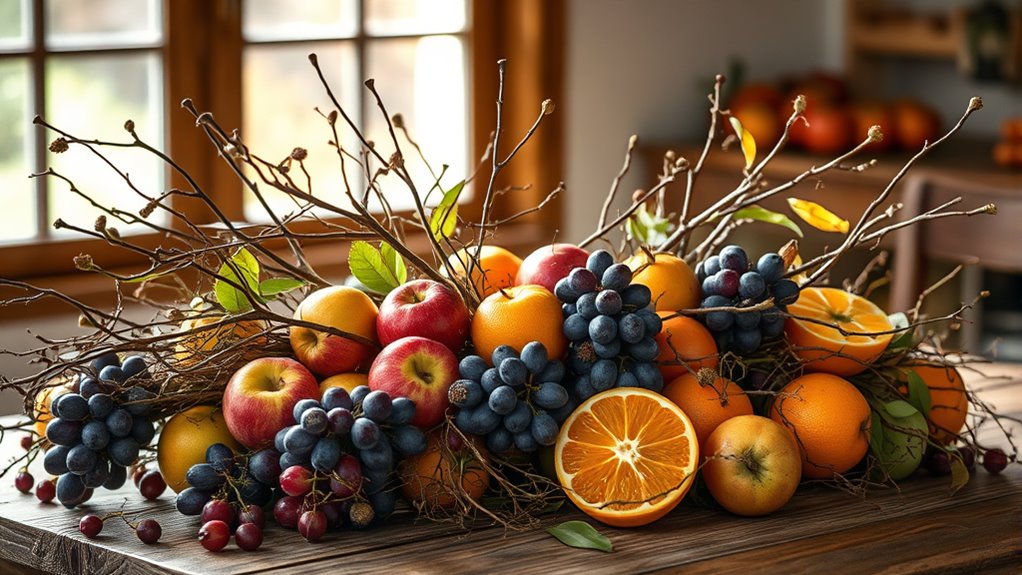Embracing natural centerpieces with fruits, vegetables, and wild branches allows you to create stunning, eco-friendly decor that celebrates nature’s seasonal beauty. By choosing responsibly sourced, local produce and natural elements, you support sustainability and reduce waste. These centerpieces bring vibrant colors, textures, and inviting scents, transforming your space with authenticity and charm. If you keep exploring, you’ll discover more ways to enhance your environment with natural, stylish touches that reflect the cycle of nature.
Key Takeaways
- Incorporate seasonal fruits, vegetables, and wild branches to create eco-friendly, visually appealing centerpieces that celebrate nature’s cycles.
- Use responsibly sourced, local, and organic produce to support sustainability and reduce environmental impact.
- Enhance sensory experience with natural scents, vibrant colors, and textured elements from fresh flora.
- Repurpose natural materials through composting or mulching, minimizing waste and promoting eco-conscious practices.
- Customize centerpieces to reflect personal style or event themes, emphasizing authenticity and seasonal relevance.

Natural centerpieces bring a fresh and eco-friendly touch to any event or home setting. When you choose to incorporate fruits, vegetables, and wild branches into your decor, you’re not only creating a stunning visual display but also supporting a more sustainable lifestyle. These natural elements can be sourced through sustainable sourcing practices, ensuring that the materials you use are harvested responsibly without harming the environment. By selecting locally grown or organic produce, you reduce your carbon footprint and promote healthier ecosystems. Additionally, embracing seasonal variations means you can enjoy a diverse range of colors, textures, and shapes throughout the year. Seasonal produce is often more abundant, affordable, and fresh, which adds vibrancy and authenticity to your arrangements while minimizing environmental impact.
When you opt for natural centerpieces, you’re embracing a versatile approach that highlights the beauty of nature’s cycles. For example, in spring, you might feature fresh tulips, daffodils, or cherry blossoms, celebrating the season’s renewal. In summer, ripe berries, colorful tomatoes, or zucchinis can bring energy and warmth to your table. During fall, pumpkins, gourds, and hearty root vegetables offer rich hues and textures. Winter arrangements might include evergreen branches, holly, and citrus fruits, which add a festive touch. By aligning your choices with seasonal variations, you ensure your centerpiece remains relevant and visually appealing, while also supporting local farmers and reducing transportation emissions associated with out-of-season imports. Understanding hydraulics and how water flows can also help in creating arrangements that are both stable and visually balanced.
Beyond aesthetics, natural centerpieces encourage sustainability by reducing waste. You can compost any leftover plant materials or repurpose them into garden mulch, closing the loop of eco-consciousness. Plus, these arrangements often require less processing and packaging compared to artificial or heavily processed decor options. You’ll find that natural centerpieces are not only environmentally friendly but also easier to customize. You can combine fruits, vegetables, and branches in ways that reflect your personal style and the theme of your event, creating a truly unique and meaningful display.
Incorporating natural elements also invites a sensory experience that artificial decor simply can’t match. The scent of fresh herbs, the vibrant colors of seasonal produce, and the tactile feel of wild branches create an immersive environment that celebrates nature’s bounty. When you prioritize sustainable sourcing and respect seasonal variations, your natural centerpiece becomes more than just decoration; it transforms into a statement of environmental consciousness and appreciation for the planet’s natural rhythms. This approach allows you to craft elegant, eco-friendly displays that speak to your values and enhance any occasion with beauty rooted in nature.
Frequently Asked Questions
How Long Do Natural Centerpieces Typically Last?
Natural centerpieces usually last about 2 to 7 days, depending on flower longevity and how well you sustain the centerpiece. To extend their life, keep them in a cool spot, change the water regularly, and trim any wilted parts. Proper centerpiece maintenance ensures your fruits, vegetables, and wild branches stay fresh longer, allowing you to enjoy their beauty and natural charm throughout your event or week.
What Are the Best Seasonal Fruits and Vegetables for Centerpieces?
You should choose seasonal harvest fruits and vegetables like pumpkins, gourds, apples, pears, and heirloom tomatoes for your edible decor. These options not only add vibrant colors and textures but also reflect the freshest produce available. Using seasonal harvest guarantees your natural centerpiece stays beautiful longer, enhancing your decor with a fresh, authentic feel. Incorporating these elements makes your table inviting and celebrates the natural beauty of the season.
How Do I Preserve Fresh Fruits and Vegetables in a Centerpiece?
Think of your centerpiece as a delicate garden in miniature; to keep it fresh, you need to master fruit preservation and boost vegetable longevity. Mist your fruits regularly with water, keeping them dewy and vibrant. Store the entire arrangement in a cool, shaded spot, and consider spritzing with lemon juice to prevent browning. These simple steps will help your natural display stay lively and beautiful longer, like a garden in full bloom.
Are Wild Branches Safe for Indoor Use?
Wild branches are generally safe for indoor use, but you should consider wild branch safety first. Make sure they’re free of pests, mold, or chemicals before bringing them inside. For indoor branch maintenance, remove any dead or damaged parts, and clean the branches gently to prevent mold. Keep the branches in a cool, dry place and mist them occasionally to maintain their appearance and prevent drying out.
How Can I Prevent Natural Centerpieces From Attracting Pests?
Think of your centerpiece as a garden gate—keep pests out with natural pest repellents. To prevent pests, regularly inspect and clean your display, removing rotting or overripe items. Incorporate pest deterrent plants like lavender or mint nearby, which naturally repel bugs. Using pest deterrent plants and natural pest repellents helps maintain a fresh, pest-free centerpiece, so your beautiful display stays inviting without unwanted critters crashing the party.
Conclusion
By choosing fruits, vegetables, and wild branches as your centerpieces, you bring a touch of nature’s artistry into your space. These natural elements create a vibrant, timeless charm—like a secret garden hidden in plain sight. Embrace the simplicity and elegance they offer, and let your decor tell a story of organic beauty. Remember, it’s not just about aesthetics; it’s about reconnecting with nature’s humble, yet extraordinary, treasures. So, go ahead—make your table a living masterpiece, straight out of a Victorian novel.









